![[EAI Opinion Review] KOREAN VIEWS 2014: Changes in South Korea’s Status and Dilemmas of Foreign Perceptions](/data/bbs/eng_reports/201504241513516.jpg)
[EAI Opinion Review] KOREAN VIEWS 2014: Changes in South Korea’s Status and Dilemmas of Foreign Perceptions
Others | 2015-04-22
Han-wool Jeong
■ South Korea with its improved image in the United States (US), Europe, Africa and South Asia
■ Worsening South Korea’s reputation in its neighboring countries - China and Japan
■ Growing security uncertainty and a higher demand for “balancing”
Introduction
The year 2015 is full of memorable events in terms of South Korea’s foreign relations such as the 70th anniversary of the end of the World War Ⅱ and Korea’s independence as well as the 50th anniversary of establishing official South Korea-Japan diplomatic ties. While going through the post-war and the cold war periods, South Korea had to find its own way to survive and prosper between the superpowers such as the US, China, Japan and Russia, overcoming the handicap of its territorial division. For the last 70 years, South Korea has not only risen from poverty but also gone from an aid recipient to one of the major economic donors, along with successful democratization after decades of dictatorship. Therefore, it is time to examine South Korea’s status in the world through empirical data and analyze how the South Korean people’s perspectives on foreign affairs have changed.
The Landscape of Perceived Global Powers
Top 3 of positively perceived countries: Germany, Canada, and the United Kingdom (UK)
The decline of G2’s global reputation
The Country Ratings Poll has been annually conducted since 2005 by the East Asia Institute (EAI) in collaboration with GlobeScan and the BBC World Service. Designed to measure 17 influential countries’ global reputation, the poll has required respondents to evaluate whether these target countries’ influence in the world is “mostly positive” or “mostly negative”. The survey in 2014 showed that Germany was ranked as the most positively perceived nation, with 60% of respondents in 21 tracking countries giving it positive ratings.
It is followed by Canada (57%), the UK (56%) and France (50%). Views on Japan whose positive ratings had reached 58% in 2012 deteriorated since the inauguration of the Abe cabinet, as shown in [Figure 2]. Interestingly, the poll finds that the perceived influences of the US and China—G2 in hard power—have continued its downward movement and both of their positive ratings dropped to 42% in 2014. Meanwhile, North Korea’s global reputation has sharply dropped along with Israel and Iran, receiving adverse attention internationally (Jeong 2014b, 15).
|
[Figure1] Views on 17 Target Countries’ Influence in 21 Tracking Countries in 2014 (%) |
[Figure2] Changes in Positive Ratings of China, DPRK(North Korea), Germany, Japan, ROK(South Korea), the US in 21 Tracking Countries since 2010 (%: average) |
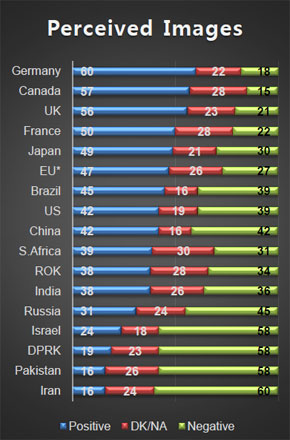 |
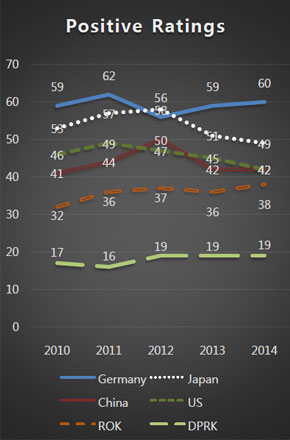 |
Source: BBC World Service ∙ GlobeScan ∙ EAI 〈THE Country Ratings Poll〉 (2010-2014).
South Korea in the World and Its Increased Global Presence
Improved South Korea’s image in major Western developed nations and Africa
Deterioration of perceptions towards South Korea is led by China, Japan, and Germany
Though having joined the Organization for Economic Cooperation and Development (OECD) and G20, South Korea is still perceived as a middle power. 38% of respondents in all the tracking countries said that South Korea plays a positive role in the global community whilst 34% expressed the opposite opinion (BBC World Service 2014). Meanwhile, in 2010, 32% gave positive responses to South Korea’s role in the global community while 29% said that the country plays a negative role.The increase in positive responses is impressive, which is nevertheless offset by its increase in negative responses. Regardless, the percentage of “don’t know” or “no answer” has decreased from 35% in 2010 to 28% in 2014. It definitely shows that South Korea is improving its global recognition (Jeong 2014a; 2014b).
The improvement of South Korea’s image took place in major Western advanced countries. For instance, the US’s positive response towards South Korea was only 46% in 2010 but rose up to 55% four years later. In the UK, the percentage of those who gave the positive responses has increased from 28% in 2010 to 45% in 2014; and in France, the percentage has also increased from 30% to 42% during the same period. It is also noticeable that South Korea is gaining wider global recognition in Australia where its influence of foreign relations with the Asia-Pacific region is fast growing since the percentage of positive responses has sharply increased from 35% in 2010 to 62% in 2014.
According to the survey about the global reputation of major countries around the world, South Korea’s image is getting better not least in African and Southeast Asian regions where the country is increasing its foreign aid. Especially on the survey conducted in 2014, positive image of South Korea continues to grow in countries which used to be less in favor of it, such as the US, Australia, the UK, and France, which is a promising sign for sure. In the meantime, it is evident that Germany has remained the most negative nation. Besides, South Korea lost its popularity in neighboring countries—China and Japan—and South American countries.
[Figure3] Average Ratings in 21 Countries and Countries’ Positive Ratings of South Korea (%)
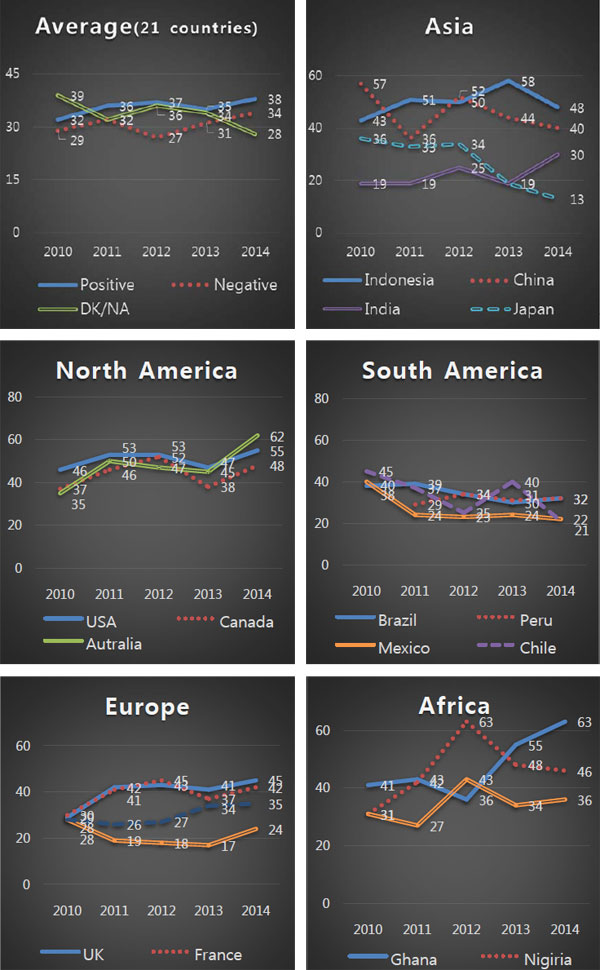
Source: BBC World Service ∙ GlobeScan ∙ EAI 〈THE Country Ratings Poll〉 (2010-2014).
Asymmetry of Public Opinion in the Korean Peninsula
South Korea’s international status and global reputation are getting improved but the situation of the Korean Peninsula is problematic. Let us compare the public opinion survey results with regard to South Korean perceptions on its neighboring countries, conducted by the EAI and Han-Kook Research Company in South Korea, CCGA(Chicago Council on Global Affairs) in the US and Genron NPO in Japan.
[Figure4] South Korean Favorability Scores towards the US, China, Japan, and North Korea
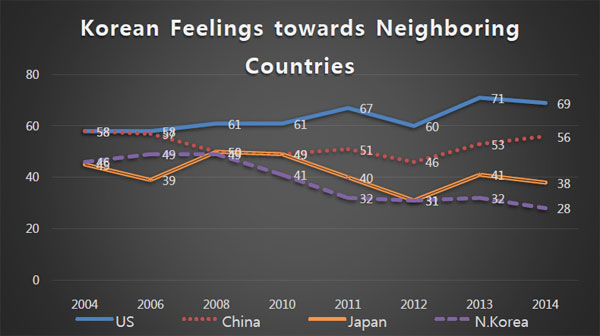
Source: CCGA ∙ EAI (2004; 2006: 2008), EAI ∙ Han-Kook Research Company (2010-2014).
[Figure5] South Korean Public Evaluations on Its Bilateral Relations with Neighboring Countries (%)
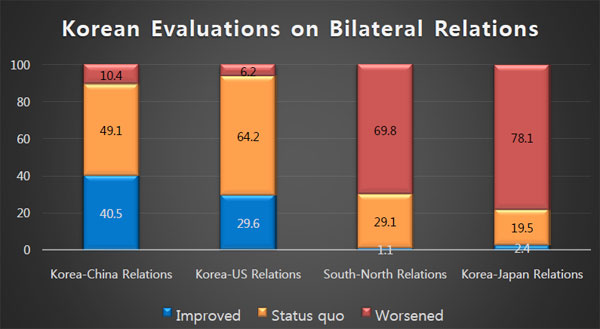
Source: EAI ∙ Han-Kook Research Company (2014)
The honeymoon period of the ROK-US relations:
The Ameliorated US and South Korean favorability scores towards each other
The worsened South Korean public sentiment towards the US as of the death of two middle school girls in 2002 has been considerably recovered for the level of North Korean material threats has escalated. The mutual recognition between South Korea and the US is considered amicable in recent times. The US favorability scores in South Korea—measured out of 100 point—rose from 58 in 2004 to 68 in 2014(Figure 4). Likewise, South Korea’s favorability scores in the US, which were only 49 in 2004, have increased up to 55 in 2014 (Smeltz and Kafura 2014, [Figure6]).
The ROK-US relations that had cooled in the early 2000s due to the Yangju highway incident, started to enter an unprecedentedly close phase (Lee and Jeong 2004, 2005; Jeong 2013a; 2013b). It is the result of the increased South Korean public support for the ROK-US alliance in the wake of the North Korean nuclear crisis, Cheonan warship sinking and Yeonpyeong Island shelling (Lee and Jeong 2010, 2011).
Besides, contrary to the Roh Moo-hyun administration (2002-2007) prioritizing the inter-Korean engagement over the ROK-US alliance, the Lee Myung-bak (2008-2012) and Park Geun-hye (2013-present) administrations have strategically distinguished themselves from the former liberal administrations by accentuating the ROK-US alliance and hard-line policies against Pyongyang. Similarly, the Obama administration (2009-present) has pursued the cooperation with allies and multilateralism in foreign policy, greatly diverging from unilateral foreign policy of the Bush administration (2001-2008). These policy changes of both sides interact and are likely to contribute to enhancing favorable attitudes mutually.
In addition, taking into account that the global image of a country is highly correlated with its economic success, it seems that South Korea’s remarkable economic achievements, along with its active role in international organizations such as G20, the United Nations (UN), and the OECD, have enhanced its global status and positive image among foreign countries including the US (Jeong 2014b).
[Figure6] American Feelings toward South Korea (Average points)
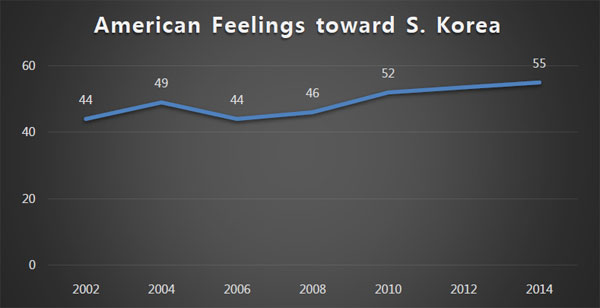
Source: CCGA ∙ EAI (2004; 2006: 2008); CCGA (2002; 2014)
Discord between South Korea and China:
Warming South Korean and Cooling Chinese Attitudes towards each other
The South Korea-China relations are in their discord. China’s favorability in South Korea, which had been continuously worsened since China’s Northeast Asia Project in 2004, turns out to have a lot improved as of 2012 when Xi Jinping and President Park took office. Though China’s favorability scores in South Korea have dropped from 58 in 2004 to 46 in 2012, they showed an upward trend with 56 scores in 2014 (Figure4). The worsened public sentiments against China first appeared in South Korea, but have made a recent turn for upwards; however, China’s positive sentiments towards the counterpart are rapidly turning to anti-South Korean trend.
On the other hand, the public opinion surveys conducted in China by CCGA and the EAI(2006-2008), the EAI(2010) and the EAI and the Asiatic Research Center at Korea University(2011)have constantly proven in common that South Korea’s favorability scores in China have undergone a rapid decrease from 73 in 2004 to 53 in 2011(Fugure7). When it comes to the Country Ratings Poll conducted by the BBC World Service, GlobeScan, and EAI on South Korea’s influence in the global community as seen from [Figure2], the positive ratings of South Korea in China were the majority in 2012 with 52%, while its sharp decrease to 40% in 2014(Figure8).
According to the South Korean public opinion survey conducted in June 2014 by the EAI and Han-Kook Research Company, 30% of the South Korean respondents said that the ROK-US relations had improved, whereas up to 40% of the respondents said that South Korea-China relations had enhanced. Contrary to this, 70% of the respondents in South Korea said that South Korea-Japan relations and the inter-Korean relations had worsened (Figure5). Though this result suggests that the government-level efforts made by both countries, South Korea and China, seem to be working at least in South Korea, it is imperative for the South Korean government to take necessary actions to deal with anti-South Korean sentiments prevailing in China.
|
[Figure7] Chinese Feelings towards South Korea (points) |
[Figure8] Positive Ratings of South Korea in China (%: average) |
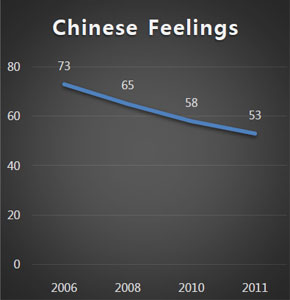 |
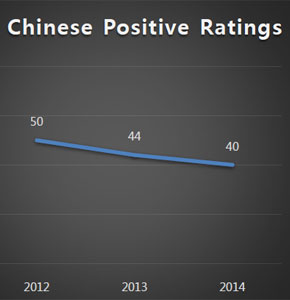 |
Source: CCGA ∙ EAI (2006-08), EAI (2010), EAI ∙ ARI (2011), BBC World Service ∙ GlobeScan ∙ EAI (2012-14)
The mutually worsened South Korea-Japan relations:
Both Japan’s favorability and Japan’s affinity for South Korea have down- trended
South Korea-Japan relations are much trickier. Japan whose global reputation is considered as good as that of Germany had failed to manage its reputation well in its neighboring Asian countries. Before Prime Minister Abe took office, Japan’s favorability ratings in South Korea were on the rise albeit moderately and the evaluations on Japan’s role in the global community had exhibited considerable improvement. However, the anti-Japanese sentiments in South Korea have been growing again after the current Abe administration reignited controversies over Dokdo Island, history textbook and the comfort women, carrying on military expansion at the same time. Whilst Japan’s favorability ratings in South Korea were up to 50 in 2010, the score dropped to 38 in 2014(Figure4). According to the 2014 survey in the [Figure5], 8 out of 10 (78.1%) South Korean respondents said that South Korea-Japan relations had worsened.
Another problem is that Japan’s high affinity for South Korea, thanks to the Korean Wave, has sharply dropped since former President Lee Myung-bak visited Dokdo. On the annual survey conducted by the Cabinet of Japan to assess how attached Japanese people feel to South Korea, 62% of the Japanese respondents replied positively in 2010. After Lee’s visit to Dokdo in 2012, however, only 39% stuck to the amiable position and the percentage plunged to 32% in 2014(Figure9). At the same survey, when asked to evaluate the current relations between Japan and South Korea, the proportion of those answered “good” was 12% while the percentage of respondents who said “bad” was 77%(Cabinet of Japan 2014).
This result casts a shadow over the 50th anniversary of establishing South Korea-Japan diplomatic ties and the American rebalancing strategy towards Asia based on assumption that allies of the US will bolster their cooperation with each other (Snyder 2014).
[Figure9] Japanese Affinity Ratings towards South Korea: “Affinity for South Korea” (%)
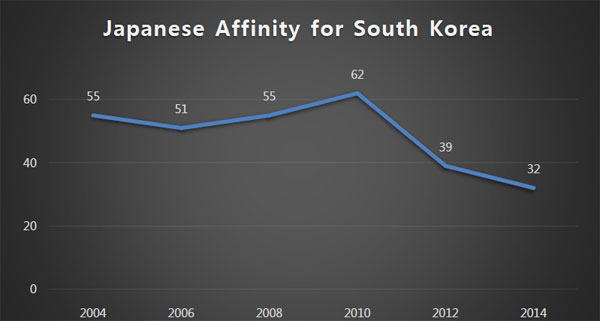
Sources: Cabinet of Japan’s Annual Public Opinion Survey (2004-2014)
South Korean Ambivalent Perceptions towards National Security
As observed in [Figure10], the level of security that the South Korean public feels has fluctuated with a wider variation and a shorter cycle since the Lee administration, while security uncertainty had elevated in a consistent direction, with less variation under the Roh administration. Such a sign of growing instability is attributed to the fact that the previously suspected North Korea’s nuclear program is now considered as a done deal and that North Korea actually imposed military threat, killing civilians in the Cheonan warship sinking and Yeonpyeong incidents.
As the degree of security threat has increased, two different opinions come to coexist in the South Korean society. The first is a traditional conservative approach, which is to emphasize the ROK-US alliance, and the second is a more liberal approach represented by the “Sunshine Policy,” underscoring the inter-Korean cooperation. Furthermore, there is also a national consensus to some extent about the need for nuclear weapons for self-defense (Figure11).
[Figure10] Perceptions of the Current Security Situation (%)
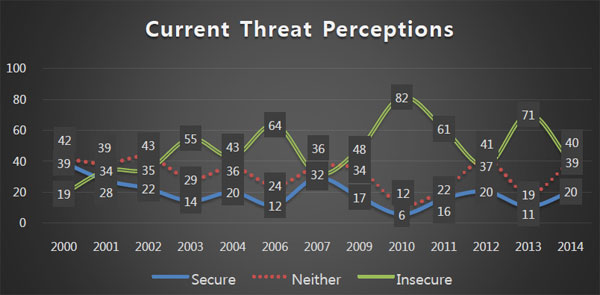
Source: EAI Database (2002-2014)
A Majority of South Koreans support the ROK-US Alliance
The primary option for the South Korean people in response to security uncertainty is to support the ROK-US alliance. The soured inter-Korean relations cause South Korean people to worry about the security situation and support the ROK-US alliance more firmly. As [Figure12] shows, the support for the alliance in 2014 dropped to 45% as perceptions of insecurity weakened. Nonetheless, the support for the ROK-US alliance has been gradually bolstered and the percentage of those who advocate the progressive policy so as to end dependence on the ROK-US alliance has remained at low level compared with the 2000s.
In the scatter diagram of [Figure13], two variables—people’s fear over national security instability and the support for the ROK-US alliance—are ordered as pairs. A correlation between variables is evident: the more fears over national security South Korean people have, the more support they have for the ROK-US alliance. In other words, the more insecure individuals feel, the more supportive they are for the ROK-US alliance as already corroborated by previous researches (Jeong 2013b).
[Figure11] South Korea’s Nuclearization (%)
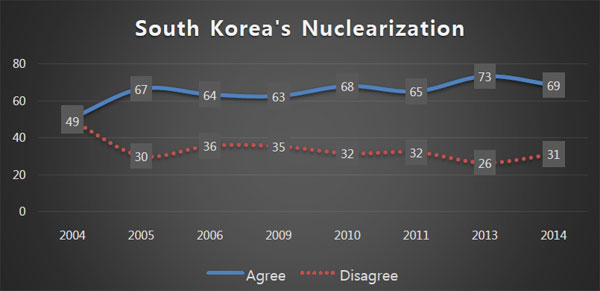
Source: EAI Database (2002-2014)
[Figure12] Future Direction of the ROK-US Relations (%)
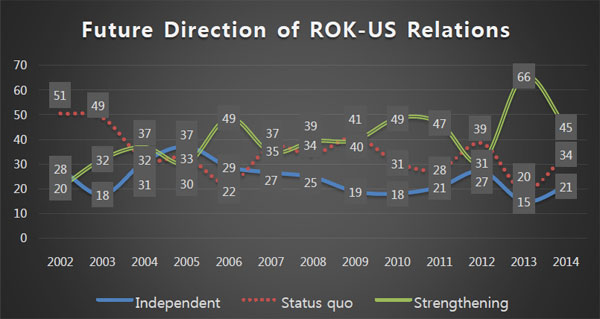
Source: EAI Database (2002-2014)
[Figure13] Scatter plot between Insecurity Perception and Support for ROK-US Alliance (2002-2014)
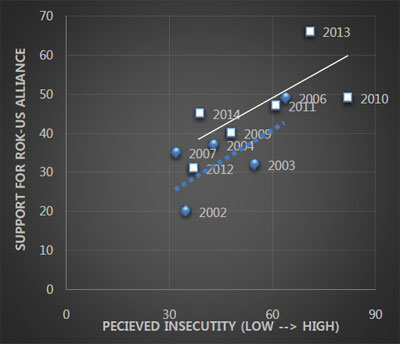
Source: EAI Database (2002-2014)
Rising ambivalent attitudes in South Korea towards North Korea
Balancing between the Liberal Sunshine Policy and Conservative hard-line policy
[Figure14] illustrates that the public opinion towards aid to the North is keenly sensitive to perceptions of the present security situation. This result implies that the two opposing public opinions—one for aid to the North and the other against it—are in a tug-of-war, as the inter-Korean relations went through a sudden change affected by the circumstances where the bilateral summit talk was held while the North Korea’s nuclear programs moving ahead behind the closed doors. Since 2008, however, the public opinion on the same issue has fluctuated with less variation and the public consensus has supported either maintaining or expanding aid to the North as the current president came to power.
[Figure15] reveals a more interesting result. It demonstrates a correlation in each cycle between the percentage of the respondents feeling insecure and that of those who support either expanding or maintaining the volume of aid to the North. Throughout the times of the recent three governments, the public opinion on security shows right downward patterns overall in that the degree of insecurity is generally in inverse proportion to the level of support for expanding and maintaining its aid to the North. When comparing the graph of the Roh administration with those of the Lee and Park administrations, however, the public opinion in favor of aid to the North was relatively low while it tends to get stronger in the two succeeding administrations.
Despite necessities for additional research, the possibility of the public’s “balancing” is worthy of note. Under the Roh administration where the inter-Korean relations were not entirely cut off but both governmental and non-governmental exchanges were maintained such as the Gaesung Industrial Complex, the public opinion was prone to check the South’s so-called “unconditional aid”. In contrast, under the Lee and Park administrations where the inter-Korean relations froze in tandem with the South’s hard-line responses against the North, the public opinion has a tendency to strike the balance by supporting the inter-Korean cooperation more.
[Figure14] Changes in the South Korean Public Attitudes towards Aid to North Korea (%)
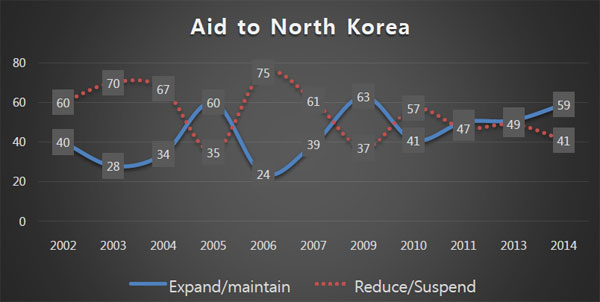
Source: EAI Database (2002-2014)
[Figure15] Correlation between Insecurity Perception and the Support for Aid to North Korea (2002-2014)
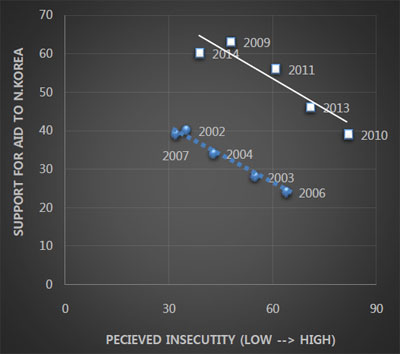
Source: EAI Database (2002-2014)
The blurred boundaries between hawks and doves
Increase of “progressive advocates for the Alliance” and “conservative-Sunshine Policy supporters”
South Korean perceptions of security have been mainly formed around North Korean and the US issues, having set a clear divide between liberals (pro-North Korea, prioritizing the inter-Korean cooperation) and conservatives (anti-North Korea, depending on US-ROK alliance). Thus far, such split between stances on security issues has been the staple product of dichotomy between the two foresaid contenting views within a unique ideological framework (Lee 2011). When examining the perception of security issues by the South Korean population since 2000, the most noticeable change is a decrease in judging security issues within the ideological framework and an increase in practical and balanced standpoint (Jeong 2013).
When classifying attitudes towards the ROK-US alliance by ideological inclinations based on the 2014 survey in [Figure16], what is noteworthy is that 39.7% of the liberals take a traditional liberal position, accentuating South Korea’s autonomous diplomacy but the other 34.9% advocate the stronger ROK-US alliance as part of 44.8% of the whole group. In 2003, the group of proponents of the strengthened ROK-US alliance was comprised of 29.0% of liberals (Jeong 2013b).
Increased supports from the conservatives have had a greater influence on growing positive attitudes in favor of aid to and engagement with the North since the Lee and Park administrations. [Figure17] shows that majority agree more with the idea of expanding or maintaining aid than that of reducing or suspending it, with no much variation by ideological inclinations. 53.2% of the conservatives (5.8% for expanding and 47.5% for maintaining) show attitudes in favor of aid. Those findings so far verify that people are making practical decisions beyond their own ideologies. Ideological and domestic conflicts over security issues in South Korea, usually described with exaggerations in SNS (Social Network Service) and the media, do not really explain the true picture of the public opinion in South Korea.
[Figure16] Opinions on the Desirable ROK-US Relations by Ideological Inclinations (%):
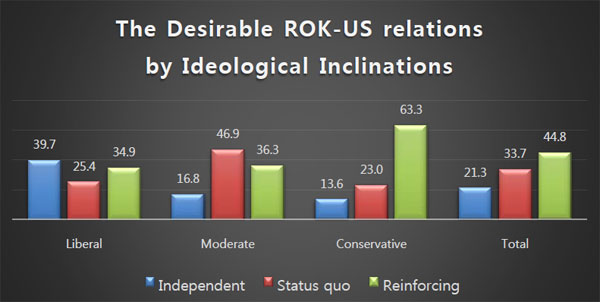
Source: EAI ∙ Han-Kook Research Company (2014)
[Figure17] Attitudes on aid to the North by ideological inclinations (%)
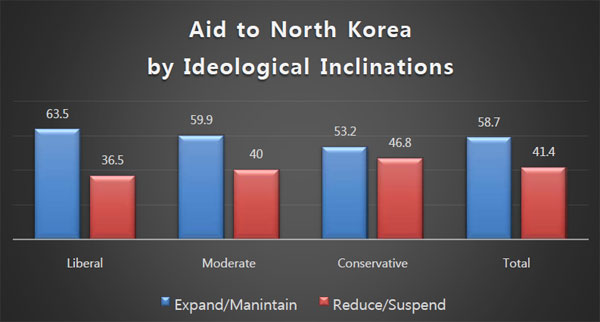
Source: EAI ∙ Han-Kook Research Company (2014)
Dilemma of “unification bonanza” policy
Coexistence of the “unification bonanza” policy and a more “cautious approach”
President Park Geun-hye again emphasized the significance of the inter-Korean dialogue and her “unification bonanza” policy at the 2014 New Year’s press conference. According to the EAI survey in June 2014, when her “unification bonanza” policy was first introduced, 55% of the respondents agreed with her approach towards unification. Public support for the policy, in the short term, had a positive impact on Park’s increasing popularity (Figure18). However, it is necessary to read both sides of South Korea’s public opinion on the issues of North Korea and unification.
While giving support for the “unification bonanza” policy, when asked about their stance on unification, 63% of the respondents said that unification should not be done in a hurry and 17% were in favor of the status quo. Only 16% said that unification should be done as soon as possible. This cautious attitude towards unification is based on the increased hostilities and hatred toward the North Korean regime (Figure 19). The first inter-Korean summit in 2000 led the South Korean public to positively expect that North Korea can act reasonably with the aids of South Korea and the global community. Yet, the public opinion has severely aggravated while witnessing the North Korea’s nuclear programs, Cheonan warship sinking and Yeonpyeong Island shelling and concluding that North Korea was still an unpredictable and irrational actor.
|
[Figure18] South Korean Support for Park’s Unification Bonanza Policy (%) |
[Figure19] South Korean Attitudes towards Unification between South and North (%) |
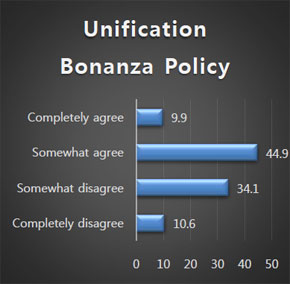 |
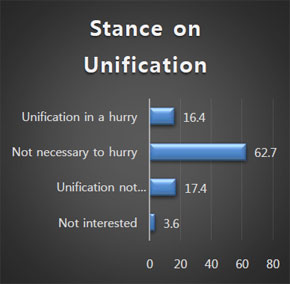 |
Source: EAI ∙ Han-Kook Research Company (2014)
More support for absorbing North Korea,
Yet, more conviction for the North Korean regime’s long-term sustainability
As to a way to achieve unification, a majority of respondents in 2004 largely favored a federal system where both the South and North Korean regimes coexist. The survey conducted a decade later, however, showed that 6 people out of 10 preferred achieving unification by absorbing the North (Figure 20). Such a change signifies that South Korean mood of seeing North Korea as rational partner has waned and hostilities towards the North have increased. Though the government is emphasizing the “unification bonanza” policy, it seems natural for the policy to confront such dilemma. Moreover, insecurity prevails with a fear that another military attack from North Korea may occur anytime in the future and the North Korean regime does not seem to easily collapse. While 8 out of 10 predicted that the North Korean regime would be sustained in the long term or would not collapse, less than 2 expected the opposite outcome. (Figure21).
When evaluating Park’s “unification bonanza” policy in terms of agenda power, “attention power,” otherwise called “stopping power” to grab the public’s attention definitely works by underlining the long-term benefits of unification. On the other hand, there are certain limits on account of “holding power”, which is to maintain the public’s attention, and “sticking power”, which is to solidify the public’s consensus and supports for the agenda (Cho and et al. 2010, 41). In order to overcome such limitations, there are necessities to eliminate the hostility and distrust existing between the North and the South as well as the public’s support for unification. North Korea needs to transform itself as well.
[Figure20] Desirable Unification Formula (%)
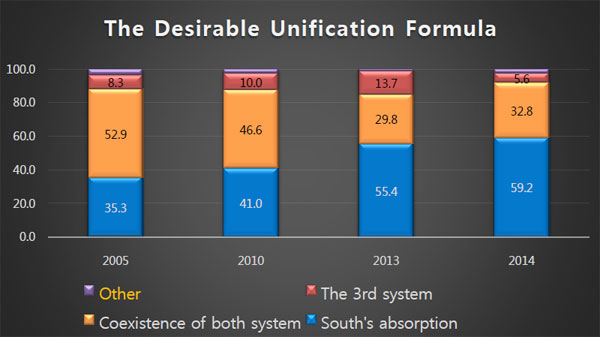
Source: EAI · ARI (2010; 2013), EAI ∙ Han-Kook Research Company (2005; 2014)
[Figure21] South Korean Prospects for the North Korean Regime (%)
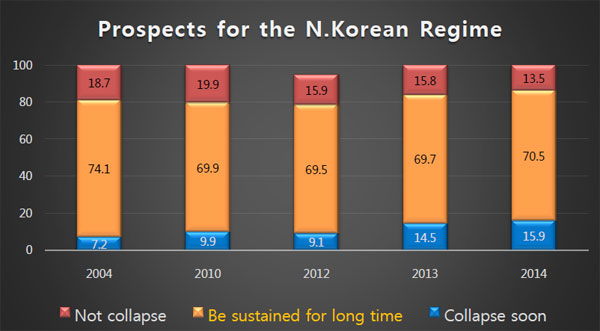
Source: EAI ∙ ARI (2010; 2013), EAI ∙ Han-Kook Research Company (2004; 2005; 2012; 2014)
Summary
While South Korea’s presence worldwide becomes to stand out, the country’s image in its neighboring countries is getting worse. This definitely requires the government to take urgent measures. With bigger threats from the North, the extended impasse of the inter-Korean relations should be something to apprehend as well. As the cycle of the North’s security threat gets shorter with its wider variation, risk factors are growing. However, neither the liberal nor the conservative approach seems to solve the problem from the public’s eyes. Consequently, the public is beginning to take more practical views beyond its ideological frames. Instead of taking a partial stance to its own ideology, a social consensus on security issues is likely to support the ROK-US alliance while balancing through engagement with North Korea followed by growing worries towards it.
It is time for both the government and political arena to demonstrate their flexible and solution-oriented leadership. They started corresponding to this changing situation at a rhetorical level. The present conservative administration developed the “unification bonanza” policy and the opposition party began seeking more “progressive advocacy for the ROK-US Alliance.” Yet, still remained at a rhetorical level, the reality has been regressive for the past 2 years. While extolling South Korea bonanza with unification, the Park administration has wasted 2 years arguing over the issue of NLL (Northern Limit Line) and “pro- or anti-North Korean” disputes. Unless it resolves the deep-rooted and chronic debates over ideological issues, South Korean diplomacy and the inter-Korean relations are hard to make a progress. This is what bothers the South Korean people and the reason why the prospects for the year 2015 are discouraging.
Nevertheless, entering President Park’s third year leadership, the year 2015 is starting with expectations in the current administration to turn over a new leaf and in the main opposition party to change. This is what the South Korean public truly wants to make it happen, celebrating the 70th anniversary of the Koreas’ independence and commemorating the 62th anniversary of the territorial division. Both the government and political arena need to reform themselves. ■
Center for Public Opinion Research
Others
#38. EAI Internship, What Lies Ahead!
Jiang Chen | 2015-04-22
Others
#37. EAI Internship, What Lies Ahead!
#35. EAI Internship, What Lies Ahead! | 2015-04-22